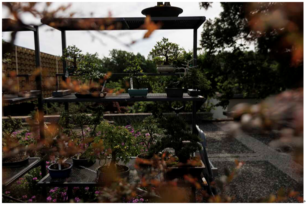Updated May 20, 202511:30 AM ET
The U.S. National Arboretum and the Potomac Bonsai Association celebrate World Bonsai Day on Sunday, May 11, 2025, with a weekend festival in Washington, D.C., featuring vendors offering bonsai, pre-bonsai, pots, accents, and supplies for bonsai artists.
*World Bonsai Day: 세계 분재의 날
*vendor: 상인

On a recent spring day, Guidry walked over in his American-flag leather boots to a bald cypress he trained that's on display at the National Bonsai and Penjing Museum in Washington, D.C.
Guidry was among visitors celebrating the 400-year anniversary of the Yamaki Pine, nicknamed the "Peace Tree."
It's the oldest tree at the museum, itself nestled at the National Arboretum.
But the bonsai tree's impressive age is not its only claim to fame.
The Yamaki Pine miraculously survived the 1945 U.S. atomic bomb attack on Hiroshima that killed around 140,000 people.
"As I understand, the Yamaki Pine was positioned in the garden near a wall, and that wall protected it just enough that it survived and continues to thrive," said Aaron Stratten, former president of the Potomac Bonsai Association.
In 1976, Japan gifted 53 trees, including the Yamaki Pine, to the United States for its bicentennial.
"So, it becomes a really interesting symbol of that renewed relationship between the United States and Japan that came from a horrible war conflict to a place of friendship," Stratten said.
The Yamaki Pine became a symbol of resilience by surviving the atomic bomb attack.
When Japan later gifted the ancient bonsai to the country that had brought deadly devastation to its people, the tree came to also represent forgiveness, reconciliation and peace.
The Yamaki family, well known for operating a commercial bonsai nursery in the city, had trained the Japanese white pine in a pot for several generations.
"It is the tree in this national collection that has been cared for as a bonsai for the longest amount of time, been in a pot, cared for, taken care of by people for 400 years," said Stratten, grinning ear to ear under his large straw hat during the celebration, which coincided with World Bonsai Day.
"And that's an amazing thing."
Curator Michael James scurries around the museum with a cart filled with greenery, dirt and tools.
He stops to give curious visitors directions and quick facts about bonsai trees, which he says brings people together.
"This art form, when it's done well, outlives you," James said, pausing to admire the Peace Tree.
"This tree is a great testament to that. That is a multigenerational art. So, it's passed down. It's passed forward to others. That's how it brings people together."
*bald cypress: 낙엽송
*Japanese cypress: 노송나무, 편백
*nickname: 별명; 별명을 붙이다
*nestle: (아늑한 곳에) 자리잡다
*The Yamaki Pine miraculously survived the 1945 U.S. atomic bomb attack on Hiroshima that killed around 140,000 people: 야마키 소나무는 기적적으로, 약 14만 명의 인명을 죽인, 1945년 히로시마에 떨어진 미국의 원자폭탄 공격에서 살아남았다.
*the Yamaki Pine was positioned in the garden near a wall: 야마키 소나무는 벽이 가까이에 있는 정원에 위치하고 있었다.
*for its bicentennial: 200주년을 기념하여
*symbol of that renewed relationship: 새로워진 관계의 상징
*The Yamaki Pine became a symbol of resilience by surviving the atomic bomb attack: 야마키 소나무는 원자폭탄 공격에서 살아남음으로써 회복력의 상징이 되었다.
*resilience: 회복력; 탄성, 탄력
*the tree came to also represent forgiveness, reconciliation and peace: 그 나무는 또한 용서와 화해, 그리고 평화를 대신하게 되었다
*known for operating a commercial bonsai nursery: 상업용 분재소를 운영하는 것으로 알려진
*Japanese white pine: 일본 백송, 스트로브스 소나무
*grinning ear to ear: 입이 귀에 걸린, 입이 찢어져라 씩 웃는
*with a cart filled with greenery, dirt, and tools: 푸른 잎과 흙, 그리고 도구들로 채워진 수레를 끌고
*outlive you: 당신보다 오래 산다
*multigenerational art: 다세대 예술
<Translation>
최근 어느 봄날, 기드리는 미국 국립 식물원 내에 위치한, 국립 분재 및 펜징 박물관에 전시된 자신의 분재인 낙엽송 앞에, 성조기 무늬 가죽 부츠를 신고 다가섰습니다.
그날 기드리는 '평화의 나무(Peace Tree)'라는 별명이 붙은 야마키 소나무의 400주년을 축하하는 방문객들과 함께 있었습니다.
이 나무는 박물관에서 가장 오래된 나무로, 국립 수목원 내에 자리하고 있습니다.
하지만 이 분재나무가 자랑하는 것은 단지 그 오랜 수령만이 아닙니다.
야마키 소나무는 1945년 히로시마에 떨어진 미국의 원자폭탄 공격에서 기적적으로 살아남았습니다.
이 공격으로 약 14만 명이 목숨을 잃었습니다.
“제가 알기로 야마키 소나무는 정원 안 벽 근처에 있었고, 그 벽이 어느 정도 보호막 역할을 해서 살아남을 수 있었다고 해요,”라고 포토맥 분재 협회 전 회장 애런 스트래튼은 말했습니다.
1976년, 일본은 미국의 건국 200주년을 기념하여 야마키 소나무를 포함한 53그루의 나무를 미국에 선물했습니다.
“그래서 이 나무는 참혹한 전쟁으로 인해 갈라졌던 미국과 일본이 다시 친구가 된, 그 새로운 관계의 상징이 되는 거죠,” 스트래튼은 말했습니다.
야마키 소나무는 원자폭탄 공격을 견디고 살아남은 회복력의 상징이 되었습니다.
이후 일본이 그 나무를 자신들의 국민에게 엄청난 고통을 안긴 나라에 선물하면서, 이 나무는 용서와 화해, 평화를 상징하게 되었습니다.
히로시마에서 상업 분재 농장을 운영하던 것으로 잘 알려진 야마키 가문은, 이 일본 흰 소나무를 여러 세대에 걸쳐 분재로 기르며, 전통을 이어왔습니다.
“이 나무는 국립 분재 컬렉션 중에서도 가장 오랫동안 분재로서 보살핌을 받아온 나무입니다. 400년 동안 화분 안에서 사람들이 애정을 쏟으며 길러온 나무죠,”라고 스트래튼은 세계 분재의 날(World Bonsai Day)에, 커다란 밀짚모자 아래서 환하게 웃으며 말했습니다.
“그건 정말 놀라운 일이에요.”
박물관 큐레이터 마이클 제임스는 푸른 잎사귀, 흙, 도구로 가득 찬 수레를 끌고, 박물관 이곳저곳을 바삐 돌아다니고 있습니다.
그는 호기심 많은 방문객들에게 길을 안내하거나 분재에 관한 짧은 설명을 덧붙입니다.
그는 분재가 사람들을 하나로 모이게 한다고 말합니다.
“이 예술은 제대로 하면, 당신보다 오래 삽니다,” 제임스는 평화의 나무를 감상하며 멈춰 말했습니다.
“이 나무는 그 사실을 잘 보여주는 증거죠. 이건 세대를 이어가는 예술이에요. 누군가로부터 이어받고, 또 누군가에게 물려주는 거죠. 그래서 사람들을 하나로 묶어주는 겁니다.”